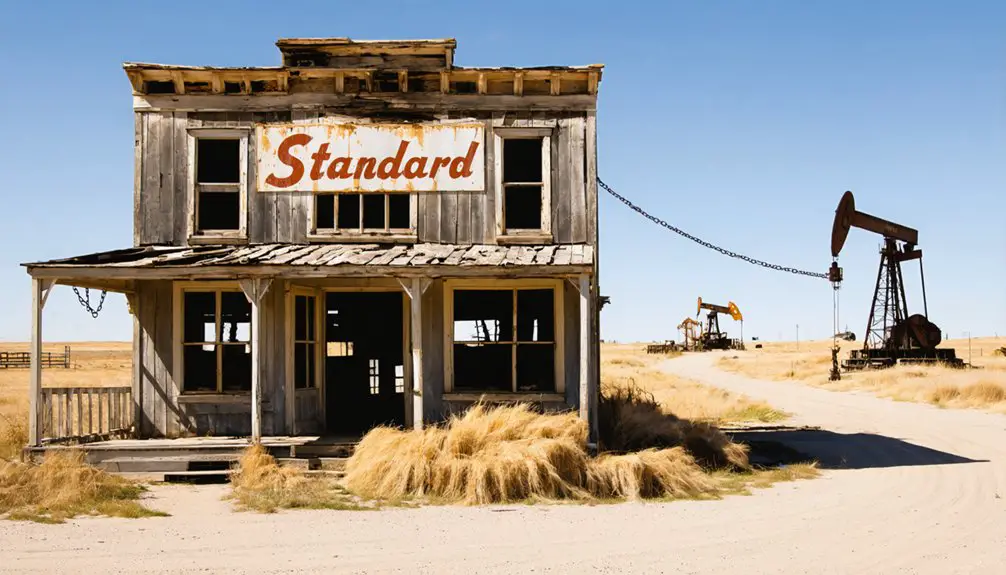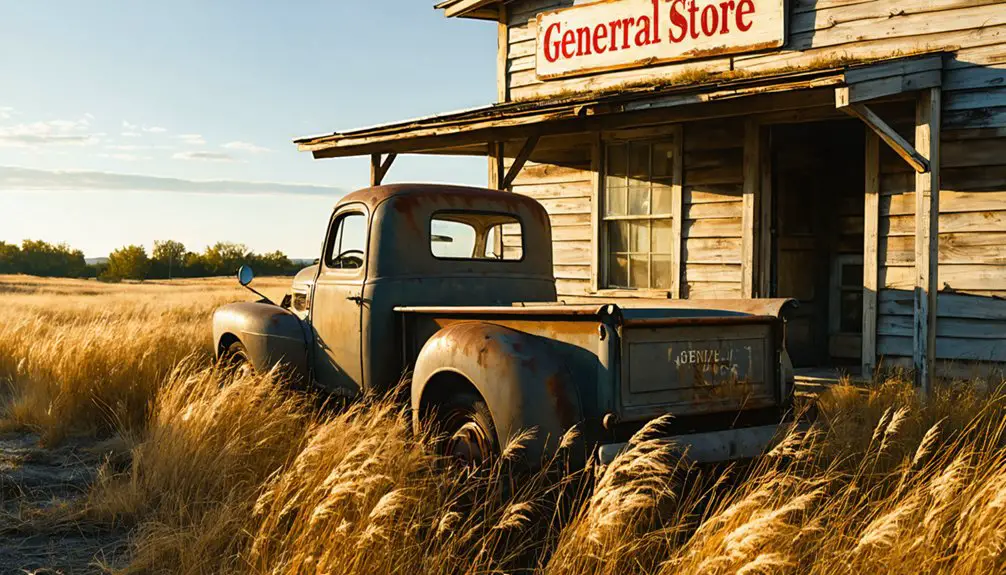You’ll find Conditville at the junction of State Highways 76 and 29, a once-bustling mining town that flourished in Oklahoma’s Tri-State Mining District during the early 1900s. The town’s zinc and lead operations employed over 11,000 workers at its peak in the 1920s, before the Great Depression triggered mine closures. Environmental contamination from mining, a devastating 1923 tornado, and declining railroad service transformed this prosperous community into one of Oklahoma’s most haunting ghost towns, where local tales suggest spirits now outnumber residents.
Key Takeaways
- Conditville flourished during the 1900s-1920s as a mining town in Oklahoma’s Tri-State Mining District, producing zinc and lead ore.
- The town’s decline began after the 1929 Great Depression, which triggered mine closures and widespread unemployment.
- A devastating tornado in 1923 destroyed vital infrastructure, contributing to the town’s eventual abandonment.
- Ghost town remnants can be found at State Highways 76 and 29 junction, featuring deteriorating early 20th-century structures.
- Contaminated groundwater from mining operations forced residents to relocate, leaving the site largely abandoned and overgrown.
Historical Origins and Settlement
While Oklahoma’s landscape was once the domain of Native American tribes like the Cherokee, Choctaw, Chickasaw, Creek, and Seminole, the settlement of Conditville emerged during the dramatic transformation of Indian Territory in the late 1800s.
The town’s establishment followed typical settlement patterns of the era, as federal policies dissolved tribal reservations and opened lands for new inhabitants. Like many of Oklahoma’s estimated two thousand ghost towns, Conditville began as a hopeful venture into building a lasting community. The discovery of rich oil deposits sparked rapid development and population growth in the region.
The town’s founding reflected the broader cultural influences of the time, with settlers primarily of European descent arriving from neighboring states. They were drawn by agricultural prospects and the promise of new opportunities.
The town’s location was likely chosen for its proximity to transportation routes, as access to railroads and wagon trails proved essential for early Oklahoma communities endeavoring to establish permanent roots and sustainable commerce.
Peak Years and Economic Activities
At its height in the early 1900s through the 1920s, Conditville’s economy centered on zinc and lead mining operations, with numerous mine shafts connected by rail lines that transported ore to broader markets.
You’d have found the town bustling with mining laborers, general stores, and blacksmith shops until the Great Depression struck in 1929, triggering mine closures and consolidations that spelled economic decline.
The town’s fortunes followed the typical boom-bust pattern of Oklahoma mining camps, where profitable extraction drove rapid growth until environmental degradation and market forces led to eventual abandonment. Similar to nearby Picher, the area saw employment plummet from over 11,000 workers during the peak 1920s mining era. The mines eventually filled with contaminated groundwater containing toxic metals, forcing residents to relocate.
Mining and Railroad Activity
Conditville’s mining operations thrived during the early to mid-20th century as part of Oklahoma’s bustling Tri-State Mining District, where lead and zinc extraction dominated the local economy.
The town’s mining techniques evolved rapidly between 1917 and 1947, meeting the intense industrial demand for these valuable metals. These operations were crucial as they helped supply war ammunition needs during both World Wars. The mining district generated an astounding $20 billion in ore during this peak period.
Railroad expansion played a significant role in Conditville’s success, as you’d find rail lines serving as essential arteries for both incoming mining equipment and outbound ore shipments.
The town’s strategic position at highway-rail junctions made it a key transportation hub. You could see freight cars loaded with lead and zinc constantly moving through the area, while passenger services brought workers to fuel the booming operations.
This infrastructure supported Conditville’s growth until mining declined in the 1960s.
Agricultural Production Peak
The agricultural landscape of Oklahoma transformed dramatically after the 1889 Land Run, and you’d find Conditville at the heart of this farming revolution.
By 1910, you’d see cotton dominating the fields, with farmers producing over 923,000 bales across the state. Agricultural innovations swept through the region as farmers embraced mechanization and crop diversification, growing everything from winter wheat to sweet potatoes alongside their livestock operations. Most farms relied on horse and mule power for their daily operations. The community reflected the state’s robust farming population, where fifty percent of Oklahomans worked in agriculture by 1920.
You’d witness the peak of farming activity between the 1910s and 1930s, when Conditville’s farmers balanced commercial crops with subsistence farming. They’d raise cattle, maintain home gardens, and produce dairy products while adapting to modern farming techniques.
This agricultural golden age began declining by mid-century as farms consolidated and the population shifted toward urban areas.
Town Commerce Timeline
During the early 1900s, you’d find a bustling trading post emerging in Conditville, anchored by several general stores and blacksmith shops serving the surrounding ranchers.
The commerce evolution peaked between the 1920s and 1940s, when local entrepreneurship thrived through feed stores, small mills, and service-oriented businesses catering to the farming community. Much like other towns during this era, Conditville experienced significant changes when oil boom prosperity brought temporary economic growth.
You’d witness the town’s decline starting in the 1950s when major highways bypassed Conditville, and agricultural mechanization reduced local demand. Like many Oklahoma settlements, the town suffered from highway bypassing that redirected traffic and commerce away from local businesses.
Without railroad connections or significant transport routes, businesses couldn’t sustain themselves.
By the late 20th century, most commercial establishments had shuttered their doors, leaving only empty buildings as silent testimonies to the once-vibrant trading center.
Today, these preserved structures stand as historical remnants of Conditville’s commercial heyday.
Local Life and Community Structure
Life in early Conditville centered around a tight-knit community of farmers, traders, and railroad workers, with Native American families – particularly Choctaw – living in nearby settlements.
You’d find the town’s social life revolving around key gathering spots like the general store, post office, and local church, where community gatherings brought folks together for everything from trading goods to sharing news.
The town’s backbone consisted of hardworking tradesmen, shopkeepers, and farming families who relied on each other for support.
Local trades flourished around seasonal agricultural demands, with neighbors helping neighbors during harvest time.
Multi-generational households were common, and you’d see simple wood-frame homes clustered near the main street, with outbuildings dotting the outskirts for livestock and equipment storage.
Factors Leading to Decline

Despite Conditville’s strong community bonds, multiple factors conspired to unravel the town’s social fabric in the early 20th century.
You’ll find that resource depletion from exhausted mining operations dealt the first blow, while transportation changes sealed the town’s fate when the new state highway bypassed it completely.
- The collapse of local mining operations led to widespread unemployment, forcing many working-age residents to seek opportunities elsewhere.
- Railroad service reductions isolated the community from crucial trade routes.
- A devastating tornado in 1923 destroyed key infrastructure that the town couldn’t afford to rebuild.
- Urban migration to larger Oklahoma cities drew away younger generations, while political influences weakened the town’s status as state funding dried up.
The combined impact of these forces left Conditville struggling to maintain its population and eventually led to its abandonment.
Notable Structures and Landmarks
As you explore Conditville’s ghost town remnants today, you’ll find a haunting collection of deteriorating structures concentrated at the junction of State Highways 76 and 29. The town’s notable architecture reveals early 20th-century design elements, though now most buildings stand empty with broken windows and failing roofs.
Local tales of ghostly sightings suggest the spirits outnumber living residents among the abandoned commercial buildings and homes.
You’ll discover traces of the town’s past through crumbling foundations, historic cemeteries, and remnants of community buildings like the old town hall and church structures.
While nature slowly reclaims these forgotten spaces, you can still make out the original street layout and property boundaries.
Scattered mining artifacts and old machinery on the outskirts hint at the area’s industrial heritage.
Regional Impact and Legacy

You’ll find that Conditville’s closure sent economic shockwaves through Oklahoma’s mining region, causing local businesses to shutter and property values to plummet in surrounding communities.
The mass exodus of workers and their families created a domino effect, with neighboring towns absorbing some displaced residents while others left the region entirely in search of new opportunities.
These migration patterns permanently altered the demographic makeup of nearby communities, leaving an aging population and transformed social landscape that persists today.
Economic Ripple Effects
The economic collapse of Conditville sent shockwaves through Oklahoma’s regional economy, creating a ripple effect that devastated neighboring communities for decades.
You’ll find that economic disparities widened as displaced workers sought opportunities elsewhere, triggering labor migration that strained resources in surrounding towns.
The collapse created lasting damage through:
- Loss of essential agricultural and commercial partnerships that once sustained the regional market
- Reduction in consumer spending power, forcing many local businesses to close
- Decreased tax revenue that crippled public services and infrastructure maintenance
- Consolidation of remaining economic activity into distant urban centers, leaving rural areas behind
These impacts transformed the region’s economic landscape, demonstrating how the fate of one town could undermine an entire area’s prosperity and self-sufficiency.
Population Migration Patterns
Beyond the immediate economic fallout, Conditville’s decline sparked a dramatic reshaping of Oklahoma’s demographic landscape that would span generations.
You’ll find that former residents primarily relocated to growing urban centers, particularly the Tulsa and Oklahoma City metro areas, following established migration trends of the era. This urban shift transformed both the communities they left behind and the cities they helped build.
The impact of these population shifts extended far beyond simple relocation numbers.
Many displaced families maintained cultural connections to their roots while contributing to Oklahoma’s urbanization. Their experiences became part of the state’s broader narrative about boom-and-bust cycles, shaping how you understand the region’s development and helping preserve the heritage of these lost communities through oral histories and local records.
Current State and Accessibility
Present-day Conditville stands as a largely deteriorated site where nature has steadily reclaimed the former Oklahoma settlement. The current conditions reveal a ghost town accessible only via rural county roads, with most structures reduced to scattered remnants amid overgrown vegetation.
Once a thriving settlement, Conditville now lies in ruins, its abandoned structures slowly disappearing beneath Oklahoma’s encroaching wilderness.
You’ll face several visitor challenges when exploring this southeastern Oklahoma site.
Key considerations for your visit:
- You’ll need a private vehicle, preferably with off-road capability, as public transportation isn’t available.
- Many areas require property owner permission due to private land ownership.
- There aren’t any visitor facilities, so bring essential supplies like water and first aid.
- Weather conditions noticeably impact accessibility, especially on unpaved roads.
The site’s deteriorated state, while challenging to navigate, offers authentic glimpses into Oklahoma’s past for determined explorers.
Preservation Efforts and Documentation

Despite significant deterioration challenges, multiple organizations have united to preserve Conditville’s history through coordinated documentation efforts. The Oklahoma Historical Society, working alongside state agencies, has implemented preservation techniques to safeguard remaining artifacts and historical records.
You’ll find thorough documentation in the University of Oklahoma’s Western History Collection, where researchers have meticulously cataloged Conditville’s story among Oklahoma’s vanishing towns.
Local preservation challenges include minimal physical evidence, but community historians actively contribute through photographic documentation and oral history collection. The Oklahoma Route 66 Museum maintains exhibits featuring Conditville’s role in regional development, while digital archives guarantee future generations can access this heritage.
You can explore these records through the Oklahoma Historical Society’s online repository, which continues to update as new documentation techniques yield additional findings.
Frequently Asked Questions
What Native American Tribes Originally Inhabited the Area Before Conditville’s Establishment?
You’ll find rich tribal history in the Spiro Mound builders, followed by Caddoan peoples like the Wichita, plus Siouan speakers including Osage and Quapaw – all of cultural significance before European contact.
Were There Any Famous Outlaws or Notable Historical Figures Connected to Conditville?
While you might expect colorful tales of famous outlaws in an Oklahoma ghost town, historical records don’t connect any notable historical figures or outlaws to Conditville, which served mainly as an oil camp and rural junction.
Did Conditville Have Any Significant Role During the Dust Bowl Era?
You won’t find significant evidence of Conditville’s Dust Bowl impact, as it’s not documented among heavily affected areas. While the town likely faced agriculture decline common to rural Oklahoma, its specific role remains unclear.
What Natural Disasters or Extreme Weather Events Affected Conditville’s History?
You’d have seen tornadoes tear through the region, floods ravage local infrastructure, and severe thunderstorms batter the town. Conditville’s location in Tornado Alley meant constant weather threats throughout its history.
Were There Any Local Legends or Supernatural Stories Associated With Conditville?
You won’t find documented ghostly sightings or haunted tales from Conditville’s past. Unlike other Oklahoma ghost towns with rich supernatural folklore, this former oil camp doesn’t have verified legends linked to it.
References
- https://www.youtube.com/watch?v=FZJc5Ivk2J4
- https://en.wikipedia.org/wiki/List_of_ghost_towns_in_Oklahoma
- https://www.youtube.com/watch?v=xg8SpCG-wDg
- https://www.okhistory.org/publications/enc/entry?entry=GH002
- https://kids.kiddle.co/List_of_ghost_towns_in_Oklahoma
- https://okmag.com/blog/a-ghostly-site/
- https://abandonedok.com/class/disappearing-town/
- https://www.youtube.com/watch?v=5d-wHDTIbb0
- https://www.wikiwand.com/en/articles/List_of_ghost_towns_in_Oklahoma
- https://allthatsinteresting.com/ghost-towns/9



